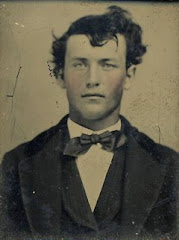
Steam tractors with steel wheels were utilized by farmers to plow fields and drive various kinds of machinery by means of long, wide, flat, belts. We did not see any farm machinery being worked the day we were there but we did see one of those tractors operate a saw mill. Here’s a picture of the tractor. You can see the drive belt on the left side of the photograph.

On the other end of the belt was this sawmill...

The steam tractor’s engine was fueled by coal and required a lot of attention. It was also a noisy beast, periodically letting off long, fierce, deafening blasts of steam.
Those powerful farm engines came on the scene in 1868 and were harbingers of radical change. Each powerful blast of steam was an assault on, and death knell for, the traditional agrarian way of life as it was then known— a way of life that was centered around home, community, and, typically, the local church.
Gasoline and kerosene-powered tractor engines were developed in the late 1800s but did not become dominant until the 1920s (after World War I). Gasoline engines were less expensive, faster to start, and easier to operate. More efficient engines and motors and agricultural machines would follow.
Factories were built. The machines begat machines. The sons of farmers traded their agrarian birthrights for the pottage of less work, more money, and all the things that more money can buy. The allure of new “opportunity” was a powerful magnet drawing the young away from the traditional way of life.
Small family farms would give way to larger, more efficient, farms until, now, according to the industrial mindset, we do not need families on the land doing the work of farming. Fewer and fewer men are needed to operate the modern machines that do the work of modern agriculture.
In traditional agriculture, children were an integral part of the work of the farm. They were trained from an early age to contribute to the family economy. They performed meaningful tasks. They were needed.
Today the work of agriculture is too dangerous for children. They are not needed. But they are not forgotten. The children of modern men now grow up with a new focus... entertainment and amusement. They have television, computer games, organized sports, theme parks, cell phones, instant messaging, i-pods, institutionalized education, and all other manner of modern flotsam.
Meaningful work for modern children? Well, of course there is still meaningful work. They can clean their rooms, feed the dog, take out the garbage and maybe even mow the lawn. And when they get a little older, we will direct them into meaningful jobs where they can learn the virtues of hard work and responsibility. Jobs like working at Burger King or WalMart or any of so many stores at the mall. Then they will go on to "higher" education where they will learn to be an integral part of the corporate-industrial world.
Farming doesn't really fit any more. What modern parent would want their child to be an independent, small-scale, family farmer? Far better is it that they become high wage earning cogs in our modern, consumption-based civilization. But I digress.
The decline and almost total destruction of agrarian culture in this nation began with the steam engine. That is what I believe to be true. Don’t misunderstand what I am saying. I do not mean to imply that the agrarian culture of our past was ideal. It was surely not perfect. But I dare say it was a way of life that was inherently superior to what we now have.
And neither am I saying that steam tractors were a bad thing. Fact is, they were a good thing. The big engines were used extensively to drive threshing machines which harvested grains like wheat and oats. Several farmers would get together and purchase one of the expensive machines. Or an out-of-town contractor would make the rounds with his machine. Threshing day was a community activity. Families traveled from farmstead to farmstead within the community to help each other bring in the harvest. The women and older girls prepared a great meal. The men and older boys worked at the threshing. The children were directed to help in various ways. It was a beautiful thing.
And therein lies much of the attraction of these old machines. They are reminders of those days, not really so long ago, when life revolved around family, the work of the family, community, and the work of the community. Deep inside, I think we all long for this lost way of life.























































































































2 comments:
Your post is very timely for me. When I was in Iowa this past weekend, IPTV had two special shows on the history of her rural society. They interviewed many of the subjects from Peter Wettach's farm photos. http://www.iptv.org/wettach/
Our society was held together by each other, because families needed each member to help, each neighbor needed help with his neighbor, etc. Very inter-dependent.
The other show was about Ageless Iron.
You're gonna make me cry!
I agree completely, of course, and share the God-given vision of a future more similar to our past than our present.
Post a Comment